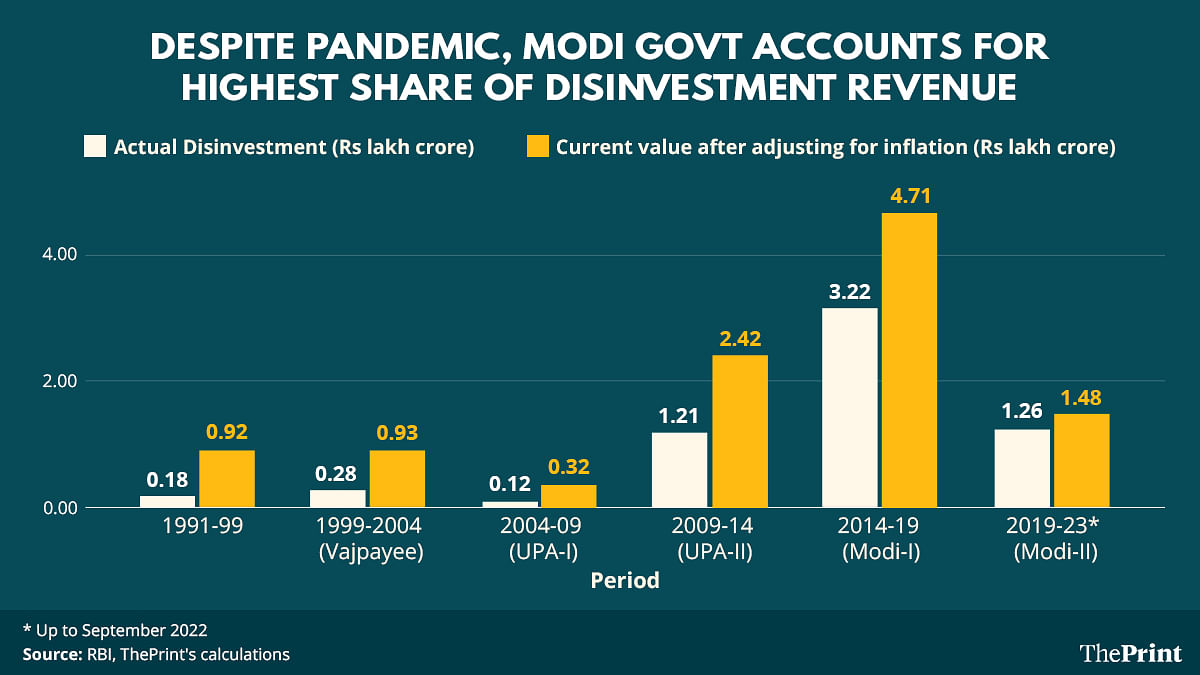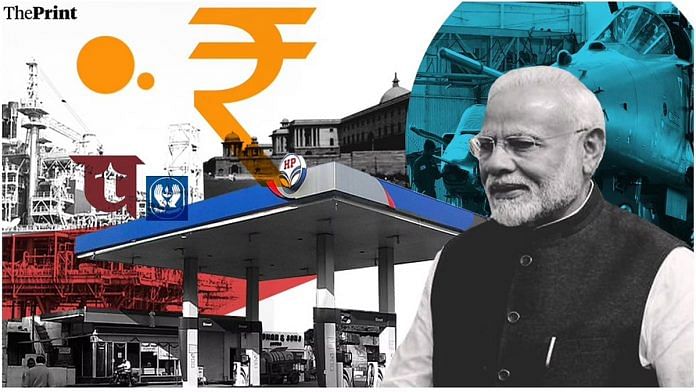New Delhi: Days after the Union budget was presented in February this year, Prime Minister Narendra Modi proclaimed that the “government has no business to do business”.
“Its [government’s] job is to think about food for the poor, make houses and toilets for them, get them clean drinking water, make health facilities available to them, make roads, to think about the small farmers. This is my priority,” he told ANI in an interview.
While the second part of his statement about what the government’s focus should be is a work in progress, disinvestment data for the last three decades shows that his commitment to getting the government out of business is not empty talk.
The Modi government’s emphasis on disinvestment has meant that it accounts for a whopping 72 per cent (Rs 4.48 lakh crore) of what has been earned from disinvestment since the process first started in 1991, an analysis by ThePrint has found.
ThePrint’s analysis of disinvestment uses data from the Reserve Bank of India (RBI) and from the Department of Investment and Public Asset Management (DIPAM) for the absolute earnings per year.
Since an analysis of absolute numbers does not take into account the inflation recorded over the last three decades, the analysis assumes a 6 per cent average annual inflation rate between 1991 and 2022. Once this is incorporated, the data shows that a still-significant 57 per cent of all disinvestment proceeds were accrued post-2014.
Also Read: Start planning to shut down sick PSUs approved by cabinet, Modi govt tells ministries
‘Minimum government’
Disinvestment of the government’s stake in public sector companies was first mentioned in the interim Budget of 1991-92 by then finance minister Yashwant Sinha, following which it was taken up in the full Budget for that year presented by his successor Manmohan Singh.
Over the subsequent years, pressures of coalition politics hindered the pace of government action on the disinvestment front, with only Rs 17,557 crore (around Rs 91,800 crore in today’s terms) being earned through this route in the eight years between 1991 and 1999.
In contrast, the Vajpayee government attempted to reaccelerate disinvestments during its term, earning Rs 27,599 crore (around Rs 93,300 crore today) in just five years (1999-2004).
The Congress-led United Progressive Alliance (UPA) government’s first term (2004 to 2009) hinged on support from the Left parties, which have historically resisted disinvestment plans. As a result, disinvestment proceeds during this period were a mere Rs 11,591 crore, just about Rs 32,000 crore in today’s value.
In UPA-II (2009-14), the Congress was on a much stronger footing in the coalition, allowing it to take more decisive steps on disinvestment. Over this period, the government earned a much more robust Rs 1.2 lakh crore (Rs 2.4 lakh crore today) in just five years.
In total, the UPA disinvested Rs 1.32 lakh crore — the equivalent of Rs 2.74 lakh crore in today’s terms — over its 10 years in power.
But it was only in 2014 that the Government’s disinvestment drive really picked up momentum. At least until the Covid pandemic derailed the progress significantly.
In the first term of the Modi government (2014-19), earnings from disinvestments totalled a whopping Rs 3.2 lakh crore, which today would amount to Rs 4.7 lakh crore. The three- and-half years up to September, including the two pandemic years, of Modi 2.0 have seen disinvestment proceeds total Rs 1.26 lakh crore, or an adjusted Rs 1.48 lakh crore, so far.

While the Modi Government has been keen on disinvestments from the beginning, the pandemic encouraged it to codify its strategy.
As part of the May 2020 Atmanirbhar Bharat package aimed at steadying the lockdown-hit economy, Union Finance Minister Nirmala Sitharaman announced a Public Sector Enterprise Policy to encourage more private sector participation while reducing the government’s role in business.
In the following Budget, the finance minister expanded on this announcement and provided the contours of the policy. According to the new strategy, the government would maintain a “minimum” presence in the strategic sectors of (i) atomic energy, space and defence, (ii) transport and telecommunications, (iii) power, petroleum, coal and other minerals, and (iv) banking, insurance and financial services. In non-strategic sectors, the public sector enterprises would either be privatised or closed down.
This is perhaps why the government’s strategy can best be articulated with Modi’s statement that “the government has no business to do business”.
Policy & Revenue
Data shows that disinvestments, although significant under the Modi government, are just a tiny fraction of the government’s other revenue sources such as income tax, corporate tax, and the Goods and Services Tax (GST).
Why then, is overwhelming importance given to disinvestment? The answer to that question is twofold.
First, despite the revenue from disinvestments being relatively small, it still serves a particular purpose, according to Ranen Banerjee, Government Sector Leader at PwC India. “Disinvestment is a very small amount compared to the overall budget, but still, it is not negligible,” Banerjee explained.
He told ThePrint: “If total fiscal deficit in the past was in the Rs 10-12 lakh crore range, and if you budget for disinvestment to be about Rs 1 lakh crore, that is still a significant portion of the total deficit numbers. So, if we are budgeting for a fiscal deficit of 4 per cent, then effectively 30-40 basis points of that is budgeted to be financed from disinvestments.”
Second, disinvestments serve as an important policy tool to open up markets in certain areas to the private sector, while also ensuring that the government gets the right price for its assets, said noted economist Rishi Shah. “They [disinvestments] need to be looked at from a strategic perspective rather than a sustainable revenue stream,” he told ThePrint.
“The fiscal authorities have been trying to bring about sustainability and predictability in revenue streams and, accordingly, the focus is on ensuring buoyancy in direct and indirect tax revenues and increasing efforts in those areas.”
Disinvestment target
For the current financial year, the government has budgeted Rs 65,000 crore as its disinvestment target. This is more conservative than the previous years’ targets — Rs 2.1 lakh crore in 2020-21 and Rs 1.75 lakh crore in 2021-22.
So far, it has met only Rs 24,544 crore or 38 per cent of this year’s target, although upcoming deals such as the disinvestment of IDBI Bank and Container Corporation of India could push it closer to its goal.
“If the government wants, it should be able to meet the disinvestment target for this year because there are smaller PSUs [public sector undertakings] that are ready for disinvestment and the market is also holding up,” Banerjee said. “The right pricing the government wants to get for disinvestment is also there.”
The more important question, he said, is whether the government needs the proceeds from disinvestment this year, given the strong tax revenues so far and the control the government has exerted over its expenditure.
“If tax revenues continue to be buoyant and revenue expenditure continues to be under control, and keeping in mind the likelihood that the outgo on MSP [minimum selling price] will be less because prevailing market rates are higher than the MSP right now, despite the hike, there could be a situation where the government won’t require additional revenues to reach its fiscal deficit target. It may plan to keep those proceeds for the next financial year,” Banerjee explained.
(Edited by Amrtansh Arora)
Also Read: Why Modi govt’s BPCL privatisation process ran out of gas and is back to the drawing board



